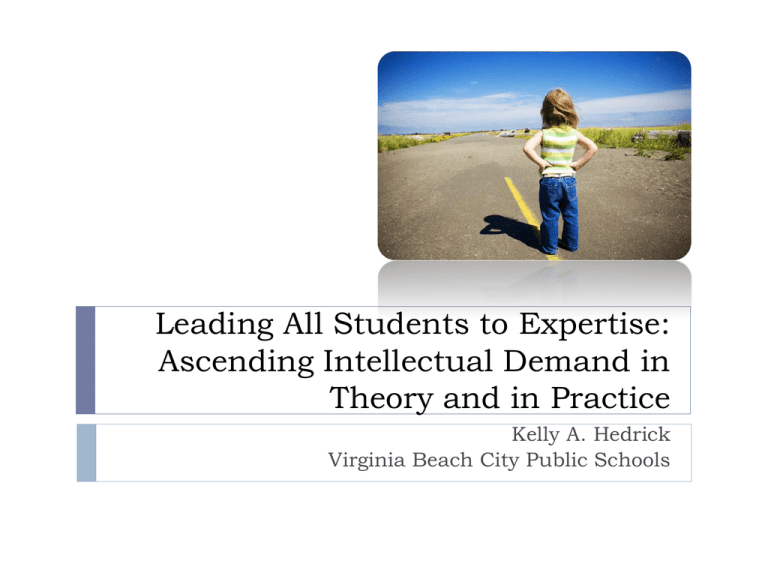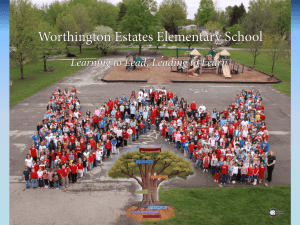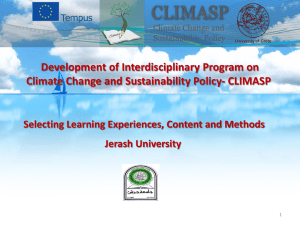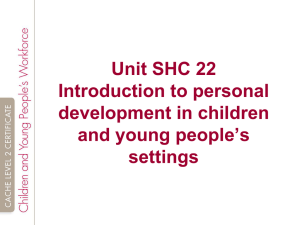Leading All Students to Expertise: Ascending Intellectual Demand in
advertisement

Leading All Students to Expertise: Ascending Intellectual Demand in Theory and in Practice Kelly A. Hedrick Virginia Beach City Public Schools Ascending intellectual demand (in and beyond The Parallel Curriculum Model) 2 Kelly A. Hedrick 2009 Assessing the Learning Plan for Ascending Intellectual Demand If we were to graph the level of intellectual development across a unit of study would it: • Require incremental increases in sophistication of thought? • Modify the organization of concepts and application of skills through gradual adjustments in challenge? • Follow a logical sequence of challenges that make sense to the learner? • Facilitate student progression toward expertise in the discipline? 3 Kelly A. Hedrick 2009 If so, it might look like this… End Begin 4 Kelly A. Hedrick 2009 Using AID in Curriculum Design Economics Concepts, Principles Applications Economics Concepts, Principles Connections to other Ideas End Applications Connections to other Ideas Begin 8th Grade Civics Course: Where does the economics unit best fit? 5 Kelly A. Hedrick 2009 Expertise Expertise is developed over time, with careful attention to the tender balance of challenge and support. 6 Kelly A. Hedrick 2009 Easy: few riffles, small waves, few or no obstructions Ascending Intellectual Demand Medium: fairly frequent, but visible rapids, obvious course, some maneuvering required Images from Rafting Difficult: numerous rapids, narrow passages requiring complex maneuvers Very Difficult: long rapids with high irregular waves and boulders, swift current, course not obvious requiring scouting from banks Exceedingly Difficult: continuously rocky rapids with irregular broken water that cannot be avoided, fast flow, abrupt bends Limit of Navigability: upper limits of skills and equipment, risk taking only for experts Source: Carol A. Tomlinson Characteristics of Experts • Experts notice meaningful patterns of information or process • Experts have a great deal of content knowledge • Expert knowledge is organized in ways that reflect deep understanding of the subject • Expert knowledge is contextualized-not just a series of facts or propositions, but reflects how information is affected by particular circumstances • Experts are flexible in their approach to new situations (adaptive expertise) • Experts retrieve information with relatively little effort • Experts are metacognitively aware • Experts are confident and competent • Experts begin problem solving at a higher level • Experts know they have much more to learn (vs. believing they have all the answers or all the answers right) Based on How People Learn: Brain, Mind, Experience and School National Research Council 1999 Developing expertise is on a continuum, a journey with no final destination other than continually and gradually refining knowledge, understanding, and skills where both attitudes and habits of mind support ongoing growth. 2009 Kelly A. Hedrick Expert Ascending Intellectual Demand Practitioner Apprentice • Manipulates 2 or more microconcepts simultaneously • Understands the • Creates generalizations that explain connections among concepts connections among microconcepts within a discipline • Selects and utilizes skills in order to complete a task • Connects information within a microconcept Novice • Experiences content at a concrete level • Manipulates microconcepts one-at-a-time •Needs skill instruction and guided practice • Seeks input from others as needed •Begins to interpret generalizations and themes that connect concepts • Exhibits task commitment and persistence when challenges are moderate • Applies skills with limited • Reflects upon both content and skills in order to improve understanding/performance supervision • Seeks confirmation at the end of a task •Requires support, encouragement, and guidance • Utilizes concepts within and among disciplines in order to derive theories and principles • Creates innovations within a field • Practices skill development independently and for the purpose of improvement • Seeks input from other experts in a field for a specific purpose • Works to achieve flow and derives pleasure from the experience (high challenge, advanced skill/knowledge) •Independent and self-directed as a learner •Seeks experiences which cause a return to previous levels in varying degrees • Reflects upon content and skills when prompted •Seeks affirmation of competency in order to complete a task Knowledge Skills Attitudes Habits of Mind Knowledge Skills Attitudes Habits of Mind Knowledge Skills Attitudes Habits of Mind Knowledge Skills Attitudes Habits of Mind 10 Kelly A. Hedrick 2009 • Focus on the unanswered questions within and across disciplines • Resources to facilitate problem finding • Thematic focus in instruction (macroconcepts) • Removal of barriers to creative production (e.g., time, space, resources) • Generalization building • Open access to other experts • Two to three concepts at a time • Interest-based extensions • Guided inquiry • Exposure to problems, resources, and innovations • Emphasis on innovation and redefining the field through the testing of existing rules • Cooperative learning for skill practice • One concept at a time • Direct instruction in skills • Guided practice • Interest-based tasks • Concept development •Open inquiry • Shared development of assessment criteria • Complex projects with authentic audience feedback • Self-developed checklists and contracts • Self-selected content, processes, products • Collaboration with experts who will advance product development and challenge ideas • Honest feedback from experts upon request Expert • Self-assessment opportunities • Monitoring checklists • Use of new skills in novel content • Reflective prompts Practitioner • Frequent and specific feedback • Chunking tasks Apprentice Novice 11 Knowledge Skills Attitudes Habits of Mind Knowledge Skills Attitudes Habits of Mind Knowledge Skills Attitudes Habits of Mind Knowledge Skills Attitudes Habits of Mind Kelly A. Hedrick 2009 Practitioner Apprentice Novice • Applies a limited range of skills in an algorithmic manner • Understands the skills and concepts in isolation, but lacks flexibility in understanding and application • Moves fluidly among the various modes and methodologies associated with language arts • Demonstrates flexibility in the use of skills and the understanding of concepts • Appreciates the art of communication • Understands the connections across written and oral communication, reading, and research • Understands the need for a variety of selections in reading, writing, and research • Practices and applies skills when prompted • Limits reading selections and resources to a narrow scope • Written and oral communication is technically correct, but lacks variety and personal relevance •Understands the role of effective communication for a variety of purposes • Values the input of qualified reviewers in the editing and revision process • Views editing and revision as punitive and drudgery • Conducts authentic research applying the skills of questioning, information gathering, data analysis and synthesis • Demonstrates knowledge, reflection, creativity, and critical analysis of language arts skills and concepts across a wide variety of disciplines • Applies the wide range of skills associated with effective oral and written communication, reading, and research with automaticity • Reading, writing, speaking, and researching lead to personal fulfillment beyond the goals of learning and the exchange of information • Appreciates the power of the written and spoken word • Understands the necessity for multiple and varied resources in research • Questions the accepted conventions and rules • Experiments with methods to communicate and develop greater understanding • Seeks the constructive criticism of knowledgeable persons across disciplines in developing a product • Adjusts communication modes according to purpose and audience • Sees written and oral communication and research with limited possibilities Expert • Applies the skills of language arts in other disciplines with relative ease • Understands and respects the diversity of language across cultures • Practices in all areas (i.e. written and oral communication, reading, and research) Expert Practitioner Apprentice Novice 12 Knowledge Skills Attitudes Habits of Mind Knowledge Skills Attitudes Habits of Mind Knowledge Skills Attitudes Habits of Mind Kelly A. Hedrick 2009 Knowledge Skills Attitudes Habits of Mind Reference: NCTE/IRA Standards for English Language Arts Use of AID: Assumptions • • • • • 13 The primary goal of high quality curriculum and instruction is the development of knowledge, understanding, skills, and dispositions associated with expertise in all learners. The foundation for expertise is developed in K-12 classrooms with careful alignment of content, models, strategies, scaffolds, and learner needs. Expertise is developed over time with careful consideration to balancing appropriate levels of challenge and support. The process of expertise development is highly personalized to the learner. The teacher continually assesses the learner at each stage of the continuum to determine learner characteristics, learner needs, and the most efficient and effective instructional responses. Kelly A. Hedrick 2009 Developing Expertise in Students Requires Masterful Teaching Characteristics of the Learner Models and Strategies 14 Scaffolding Techniques Kelly A. Hedrick 2009 Apprentice •Tests and manipulates existing theories, principles, and rules Novice •Sees science as a body of facts and skills •Seeks algorithmic tasks; ambiguity causes discomfort •Experimentation is an end in itself rather than a means to an end •Sees a disproved hypothesis as a failure •Inadvertently includes and fails to manage multiple variables Expert •Challenges existing theories, principles, and rules through research and experimentation •Makes a contribution to the discipline and or field (e.g. new experiments, new observations, new methods and tools, new theories, principles, and rules) •Understands and appreciates that scientific knowledge is never declared certain •Sees science as a body of concepts and recognizes connections among the microconcepts •Analyzes existing theories, principles, and rules Practitioner •Poses new scientific questions •Uses existing scientific questions for research and experimentation •Operates comfortably in the ambiguity that characterizes science •Tolerates the ambiguous nature of science •Effectively manipulates multiple variables within an experiment •Manipulates one variable within an experiment with ease •Plans for and observes a wide range of factors (variables, constants, controls) and discerns patterns •Understands, identifies, and analyzes the relationships among the independent and dependent variables, constants, and controls •Understands and assesses the relationships among the fields of science and other fields across multiple disciplines •Seeks and derives satisfaction from the ambiguous situations in science •Conducts complex experiments with ease and fluidity; freely manipulates methods, tools, knowledge, and self to achieve desired results. •Uses mathematics as the language of science. Expert •Uses mathematics to conduct scientific work •Science is isolated from other disciplines •Poses original scientific questions that test the limits of the existing body of knowledge Practitioner Apprentice Novice 15 Knowledge Skills Attitudes Habits of Mind Knowledge Skills Attitudes Habits of Mind Kelly A. Hedrick 2009 Knowledge Skills Attitudes Habits of Mind Knowledge Skills Attitudes Habits of Mind Reference: Benchmarks for Science Literacy; American Association for the Advancement of Science Literacy: Project 2061 16 Kelly A. Hedrick 2009 17 Kelly A. Hedrick 2009 Scaffolding Scaffolds are intended to support the learner at each stage of development on the continuum toward expertise. The selection of a scaffold is critical in creating a balance between challenging and supporting the learner. Too great a scaffold and the teacher will diminish the challenge creating “easy” access to successful completion of a task. Too small a scaffold and the student struggles to the point of frustration and gives up on the task because it is too far beyond his readiness. Scaffolds are intended to be temporary ladders to assist students in their dissonance as they make sense of content and skills en route to expertise. 18 Kelly A. Hedrick 2009 19 20 21 22 23 Careful Observations Compare the characteristics, models & strategies, and scaffolds associated with the novice and those features associated with the apprentice. What are your observations? 24 Kelly A. Hedrick 2009 25 26 27 28 29 Reflection on the Science AID How do models, strategies, and scaffolds change along the science AID continuum? 30 Kelly A. Hedrick 2009 Practitioner Apprentice Novice • Connects the relationships among mathematical facts and skills through concepts • Applies the skills of discrete mathematics, but lacks a conceptual understanding • Computes fluently and makes reasonable estimates • Identifies the principles, but cannot apply them unless prompted • Makes connections across mathematical ideas • Sees limited relationships among numbers and number systems • Develops skills and understanding through complex problem solving • Needs frequent feedback and assurance during problem solving • Makes appropriate selections about which tools and methods to use •Sets goals that extend beyond computational accuracy •Uses computation as merely a means to an end • Questions existing mathematical principles • Moves easily among the fields of mathematics through the use of macroconcepts • Links mathematical principles to other fields through real world problems • Seeks the challenge of unresolved problems and the testing of existing theories • Applies skills with automaticity • Understands change in a variety of contexts • Uses a variety of tools and methods with efficiency in the analysis of mathematical situations • Understands the principles that frame a field (i.e. measurement, algebra, geometry, statistics) • Identifies only the most basic patterns • Uses the principles of mathematics to make connections among concepts across multiple fields within mathematics • Understands patterns, relations, and functions • Applies skills with confidence and develops greater understanding beyond number and operations • Computes efficiently, but lacks fluency Expert • Appreciates the role of mathematics in other disciplines • Seeks flow through the manipulation of tools and methods in complex problem solving • Views unanswered questions in other disciplines through the concepts of mathematics • Uses reflection and practice as tools for selfimprovement • Formulates questions for research that can be addressed through one or more fields of mathematics Expert Practitioner • Sees the “right answer” as the goal Apprentice Novice 31 Knowledge Skills Attitudes Habits of Mind Knowledge Skills Attitudes Habits of Mind Kelly A. Hedrick 2009 Knowledge Skills Attitudes Habits of Mind Knowledge Skills Attitudes Habits of Mind Reference: Principles and Standards for School Mathematics National Council of Teachers of Mathematics Models and Strategies for the Novice in Mathematics Kaplan’s Frame of the Discipline: students “frame” their work through the lens of an expert in a particular field of mathematics. Cooperative Learning: working collaboratively is an important part of any social studies environment as student work mirrors that of expert scientists; providing students with a variety of partners in multiple configurations serves as a scaffold because they share ideas, resources, verbalize their theories, and formulate conclusions. Information gathering with a partner or team assists those students who become overwhelmed by the organization of data. Concept-based curriculum (Erikson’s Model) to focus students on the explanatory themes and concepts in order to make connections. Wasserman’s Play-Debrief-Replay: students are given materials and instructed to “play” with them to see how they work or act; direct instruction follows in the form of a mini-lesson where the focus is on content knowledge; students return to the materials with more specific instructions (e.g., activity or structured inquiry) 32 Exit Tickets: ongoing assessment information is critical in order to differentiate both content and inquiry for students. An exit ticket asks the students 1-2 questions about the day’s lesson and/or their grasp of the science content and processes. Teachers use the information from the exit tickets to determine who is ready for more advanced work, who is at grade level with the work, and who needs more scaffolding in order to be successful. Scaffolding for the Novice in Mathematics Model processes, including modeling for problem solving Use of manipulatives Use of visualization of equations Practice application of math concept-explanation of real world Use children’s literature to engage and spark student interest in mathematics Introduce students to real experts in mathematics from a variety of cultural and ethnic groups Develop metacognitive reflection through prompts in order to focus students on the efficiency and effectiveness of their problem solving rather than on computation and getting the “right answer” Identify real world problems where mathematics is the root to all or part of the problem to provide a context of the introduction and practice of basic skills 33 Construct models to communicate understanding Models and Strategies for the Apprentice in Mathematics Use of real world investigations-student are immersed in the problem first and then given direct instruction as needed in solving the problems Use of rubrics to clearly articulate expectations for quality work and levels of performance Process logs for ongoing reflection and analysis of work Orbital: students participate in interest-based enrichment opportunities that inform the unit of study at hand. Orbitals tend to be short adventures for students in areas of personal interest. Process and product are determined by the learner. Use of performance tasks to assess understanding and complex problems Kaplan’s Frame of the Discipline: students “frame” their work through the lens of scholars and practitioners who use mathematics. Group investigation in which students organize data, discuss data, and create ways to represent data Mini-lessons to focus on specific knowledge and skills Think Aloud for reflective analysis of a process in a step-by-step manner 34 Scaffolding for the Apprentice in Mathematics Whole group, small group, and individual on problem solving and application of skills and concepts Modeling and specific feedback on the use of technology tools for data collection, analysis, and representation (Graphing calculators, probes, spreadsheets, data basis) Provide specific feedback and an opportunity for self-assessment targeted at helping the learner grow. Feedback should be focused and specific enough to correct misperceptions about content knowledge and facilitate growth with process skills. Provide support in determining the most appropriate way Provide guided practice and specific feedback in a variety of problem solving methods Guided practice in solving “fuzzy” problems where information is incomplete or misleading Continue using manipulative but shift to student directed use of tools Modeling mathematical concepts as they are applied in other discipline (music, science, architecture, landscaping) 35 A Different View of Mathematics Instruction How does use of the AID in mathematics teaching differ from “traditional” instruction in this discipline? 36 Kelly A. Hedrick 2009 Models and Strategies for the Practitioner in Mathematics Independent study-student selects topic, processes, products, and resources; feedback focuses on alignment of research purpose, process, products, and results Kaplan-rules over time, rules from different perspective, and unanswered questions in mathematics in other disciplines (science, sociology, economics) Simulations Internships, apprenticeships, in fields that rely heavily on mathematics knowledge and understanding (e.g., forensics lab, doctor’s office, computer fields) Partnerships with mentors to write for peer-reviewed mathematical journals; this may include writing for mathematics education journals with teachers at the middle school and high school levels Socratic Seminar or paidaea to explore unanswered questions within the field of mathematics 37 Scaffolding for the Practitioner in Mathematics Have students analyze qualitative and quantitative research in order to identify the role of mathematics in differ types of studies Using analysis of research to determine the effectiveness of methodology Familiar models applied to new problems Exposure to the unanswered questions in the field of mathematics including models for addressing them Collaboration with other practitioners and experts in theoretical and practical applications in structured learning and working environments 38 Opportunities and resources to test mathematical rules, theories, and applications Opportunities for Continued Growth for the Expert Teaching graduate or undergraduate courses in mathematics Publishing Works collaborative with experts in a variety of fields in pursuit of resolution to unanswered questions Designs and conducts studies to test existing theories Develops new theories Develops mathematical models and explanations for situations and phenomena found in the real world Uses mathematical patterns and trends to predict future conditions (e.g., spread of disease, homelessness, economic trend, natural trends-bird migration) Seek grants to fund research 39 Practitioner Apprentice •Understands history at the conceptual level Novice •Seeks connections among microconcepts in order to make sense of historical patterns and trends •Defines history as isolated people, places, and events •Sees the facts and skills, but not the concepts that link them •Poses historical research questions •Studies history through rote memorization •Has a clearly defined sense of chronology •Needs experiences with sequencing to establish a sense of chronology •Understands the complexity of causes and effects •Recognizes the importance of perspective in historical events, human perspectives, and consequences •Identifies causes and effects as isolated events •Lacks an appreciation for history and its relevance to self and the world in the present and the future Expert •Analyzes contemporary events through an historical lens with automaticity •Moves easily from the theoretical to the practical and vice versa in response to a situation •Understands chronology, but has the ability to follow themes across events and time periods regardless of the direction (present to past, past to present) •Challenges accepted bodies of knowledge, methods, and research findings •Identifies unanswered questions and crafts researchable questions to investigate them •Develops themes and connections across historical events, periods, and fields without reliance, but acknowledgement of chronology •Uses the knowledge and skills of the discipline across diverse fields and disciplines •Displays curiosity and seeks challenge through unanswered questions in the field •Understands the social, political, economic, and technological influences on patterns and trends •Marvels at the richness of history and its importance in shaping the present and future •Understands and appreciates the influence of individual experiences, societal values, and traditions on historical perspectives •Systematically and with automaticity utilizes the knowledge, skills, and processes of the discipline to investigate Expert Practitioner Apprentice Novice 40 Knowledge Skills Attitudes Habits of Mind Knowledge Skills Attitudes Habits of Mind Knowledge Skills Attitudes Habits of Mind Kelly A. Hedrick 2009 Knowledge Skills Attitudes Habits of Mind Reference: Curriculum Standards for Social Studies National Council for the Social Studies Models and Strategies for the Novice in History Question Stems: one of the most challenging aspects of inquiry is the formulation of a testable scientific question; question stems are the beginning part of a question that assist students in forming their own question by completing the stem. Another form of the question stem is the Question Cube. There are two cubes with words such as who, what, how, why, and when. Students roll both cubes and create a question using both words. While Question Stems and Question Cubes assist students in formulating scientific questions, the novice scientist needs help in selecting the most appropriate question for the topic, concepts, materials, and experimentation goals. Concept Mapping: students create a map of ideas based upon the big ideas in their study. A concept map focuses on major and sub-concepts rather than topics. Connections are a critical element of a concept map and these often lead to the formation of a generalization. Mind-maps are an excellent precursor to concept mapping. Web Quests for exploration in topics of interest and interaction with content information Use visualization in order to help students remember the sequence of events. 41 Scaffolding for the Novice in History • In teaching history as a story, develop the use of graphic organizers to tell the story including concept maps. • Focus on deductive reasoning in the collection of facts and topics in order to form a generalization • Teach the difference between descriptive research versus historical research • Use video streaming in presentations and student presentations • Use whole group and small group and analysis and interpretation of primary and secondary source documents • Use role plan and interview “historical character” to enable students to “experience” their story. • Use timelines with students to establish a sequence of events 42 Models and Strategies for the Apprentice in History Kaplan’s Frame of the Discipline: students “frame” their work through the lens of an expert in a particular field of history. Expand students’ use of the frames of the discipline frame within the field of social science (such as anthropologist, historian, political scientist, sociologist, psychologist, and economist). Encourage student use of multiple frames (perspectives on a single event) Debate to encourage the application of information in the construction and defense of an argument Socratic Seminar to promote discussion of information, generalization formation, and supporting generalizations with facts and reasoning Dimensions of Learning with an emphasis on error analysis, constructing support, and decision making Synectics-to encourage students to make connections among abstract thinking Marzano’s error analysis to analyze historical fiction 43 Scaffolding for the Apprentice in History • Model the development of historical research questions • Train in historical inquiry • Provide interest based differentiation in order to explore personal areas of interest • Provide specific feedback and an opportunity for self-assessment targeted at helping the learner grow. Feedback should be focused and specific enough to correct misperceptions about content knowledge • Provide support in determining when it is most appropriate to gather information from primary or secondary sources. • Use of photographs, movies, and paintings (prints) to assist students in seeing historical events • Use simulations to enable students to experience historical events, conditions, and perspectives 44 Models and Strategies for the Practitioner in History Kaplan’s Depth and Complexity Dimensions: in order to help students think in deep and complex ways about the science content they are required to know, the elements of depth (i.e., language of the discipline, details, patterns, trends, unanswered questions, rules, ethics, and big ideas) and complexity (i.e., points of view, over time, and interdisciplinary). Focus should center on unanswered questions and ethical issues. Marzano’s Historical Investigation-students identify a situation in history with conflicting viewpoints. Students develop a hypothetical scenario with one or more viewpoints. Students then research and analyze information in order to determine the plausibility of the hypothetical scenario Orbital: students participate in interest-based enrichment opportunities that inform the unit of study at hand. Orbitals tend to be short adventures for students in areas of personal interest. Process and product are determined by the learner. Use of performance tasks to assess understanding and complex problems 45 Internship or mentorship with an expert in an area of interest (e.g., civil war battleground, college/university, historical museum, library) Scaffolding for the Practitioner in Exposure to a variety of research models that can be applied to historical research Analysis and interpretation of varied viewpoints on a topic Emphasis on research ethics Specific feedback from the teacher and outside “experts” on various design elements in the experiment Library and technology support to enhance expertise in advanced research methods and organization of information Student-centered critiques based on evidence Analysis of historical patterns and trends over time (making connection past, present, future) Use simulations to enable students to experience historical events, conditions, and perspectives 46 Opportunities to Support Continued Growth for the Expert Teaching graduate or undergraduate courses in the field of history Publishing Field studies (civil war historian traveling to different libraries) Collaborate with experts in the field that share the same perspective Development of documentaries 47 Planning the Path To Expertise Identify the characteristics of the learner at each stage along the AID continuum. Identify the desired results (learner targets). Determine acceptable evidence (how will you know when the learner has achieved the desired results? Plan the instructional sequence using models and strategies most appropriate to the discipline and the needs of the learner. Continually assess learner growth and needs; adjusting the level of challenge and the scaffolds accordingly. 48 Kelly A. Hedrick 2009 A Final Thought Expertise is developed over time with careful attention to the tender balance of challenge and support. Kelly A. Hedrick 2009








